、.
-.. V*'.
» • » •• •
> 二
-■
• I
nRJ
• v ..
>、•:;^u运 m>、
,f v»■»«;•_ - -
... nT juui i
K
JnHti ^.
^vrrrrvl
o^il
■声-----
O-K > r^npl.hl - - - -
V_—
M__r
fll ypy i r. r i> 声,,尸尸尸产
—
^
卢In
t
友
被~£
;i
^
r
轉^'
:-
1*1®圖ilL
[
厂:
II
:
i
i
s
r
n
k
v
^
H
K
i
^
S
J
P
—
發
^5a
、、_T
^l^X ;/■
'.lllLyi.idt ■^rEBL 一
「f f If jall - liii lBI
si
M
; .£*■
:
.
..
1
Ififi
.^iy
iMILJ
11B..
iSiil4
SB
!ly
..
t
i1-
-
-
1
i
l
!
■
l
•
i
l
l
i
l
^
L
W
j
y
r
p
“
尹:
蛛
兵
口
Z
二一 *• 1 - 1
;
JLT^ST^S5v々 IV,立
• ^,4C
4^. *A
rrsr^4^-i
r^r^lLr、為:^A
^
p
^
r
z
^
一
.«1 1 二> 二 ‘i
》
. , (Hut r. -ajfj^
t
^
I
m
.m
_
i
’
j
g
'
l
a
i
[
,
_
W
$
S
~
^
-
.
f
e
■
碎
链
,
-
德
^
-
t
e
s
:
•
'
-
鐵
戾
1
祐
綠
约
i
f
e
f
e
u
v
!
::-
,
'
^
3
MhHRH ^Nhu^
*w
?r
U
j!r馨 ppjiJ4“嘴*
1
�
A硪MsooS2A1
lnloJtv<
Jse!J}l
SJyuslsoais.^UTAca CMDs/a^
puv -Mspl
OOJ
J-iov 妁v
tfC
&
io^<
.llslvjodjou
AN
◎1.
i
L
.
_
_
_
_
l
£al>e4o
a«
l
a定
s
souJo
s
.
C
CUU IVOIJOJBJulmas J.yf
>UJ
~^U‘LSZ
's.?cs p^advpls..
SBOJ一ao
益 ololilpyl fosmiisul.
�
This book is in the
Ac3di^on-V/os!ey Series in Computer Science
Consulting Editor
Michael A- Harrison
Library of Congress Cataloging in Publication Data
Mead, Carver A
Introduction to V LS I systems.
1-
Integrated circuits— Large scale integration.
2. Microcomputers.
4. Computer architecture.
II. Title,
joint amiior,
TK7874.M37
_
ISBN 0-701-04358-0
3. Digital electronics.
I* Conway,Lynn A .,
621.381^535
73-7468S
Second printing, October 1980
O
Copyright ◎ 1980 by Addison-Wesley Publishing Company„ Inc. Philippines copynght i9f>0 by
Addison-Wcsley Publishing Company, [ac.
All rights reserved. No part of this publication may be reproduced, stored in a retrieval system, or
transmiltcd, in any form or by any means, electronic, mechanical, photocopying, recording, or
otherwise, without the prior wnuen permission of the publisher. Printed in the United States of
America. Published simtiltaneoutsly in Canada, Library of Congress Catalog Card No. 78-74688.
ISBN 0-?01-0435S-0
FGHIJKLMN-KA-8站765432
�
TO W. R_ SUTHEHLAND
�
A W ..:..'...:.-.
PREFACE
What we have seen so far is only the beginning. Achievable circuit density
now doubles with each passing year or two. Physical principles indicate that
transistors can be scaled down to less than 1/100th of their present area and still
function as the sort of switching elements with which we can build digital systems.
By the late 1980s it will be possible to fabricate chip's containing millions of
transistors. The devices and interconnections in such very large scale integrated
(VLSI) systems will have linear dimensions smaller than the wavelength of visible
light. New high-resolution lithographic techniques have already been demon
strated that will enable fabrication of such circuitry.
VLSI electronics presents a challenge, not only to those involved in the
development of fabrication technology, but also to computer scientists and com
puter architects. The ways in which digital systems are structured, the procedures
used to design them, the trade-offs between hardware and software, and the
design of computational algorithms will all be greatly affected by the coming
changes in integrated electronics. We believe this will be a major area of activity in
computer science on through the 1980s.
As a result of improvements in fabrication technology, Large Scale fntegrated
(LSI) eieclronic circuitry has become so dense that a single silicon LSI chip may
contain tens of thousands of transistors. Many LSI chips, such as microproces
sors, now consist of multiple complex subsystems, and thus are really integrated
systems rather than integrated circuits.
Until recently the design of integrated circuitry has been the province of
circuit and logic designers working within semiconductor firms. Computer ar-
diitects. have traditiorrally composed systems from standard integrated circuits.
designed and manufactured by these firms but have seldom participated in the
specification and design of these circuits. Electrical Engineering and Computer
Science (EE/CS) curricula reflect this tradition, with courses in device physics
and integrated circuit design aimed at a different group of students than those
interested in digital system architecture and computer science.
,
-
...........
r
r
f j J
s •'-;.
w ‘•
^
■
^
�
-------------- ----------1 ---------- ' .........................................................
..............................................-
'
'
”
-
- -------------- --------
一
.
.
-
k
d
vj
Preface
This text is written to fill a current gap in the literature and to introduce all
EE/CS students to integrated system architecture and design. Combined with
individual study in related research areas and participation in large system design
projects, ihis text provides the basis for a graduate course-sequence in integrated
systems. However, it is primarily intended for use in intensive undergraduate
courses on the subject. The material can also be used to augment courses on
computer architecture. We assume the reader's background contains the equiva
lent of introductory courses in computer science, electronic circuits, and digital
design.
There have been major obstacles in the way of those seeking an overall
understanding of integrated systems. Integrated electronics has developed in a
heatedly competitive and often secretive business environment. There lias been a
proliferation of different device technologies, circuit design families, logic design
techniques, maskmaking and wafer fabrication techniques, etc. Many of these
technologies have sprung up from the grass roots of “ Silicon Valley,,in the San
Francisco Bay Area of California, and thus many of the “ experts” are located in
that one region. Most workers in the industry have concentrated on narrow
specialties. Separate integrated electronics cultures have independently evolved
within many companies, and thus the terminology and practices of the specialties
vary from company to company.
As a result of this background, texts on integrated electronics have tended to
give detailed accounts of some very narrow horizontal segment of the overall
subject, such as device physics or circuit design, and are often tied in subtle ways
to some specific context, thus limiting their general applicability.
We have chosen instead to provide just enough essential information about
devices,circuits, fabrication technology, logic design techniques, and system
architecture to enable the reader to fully span the entire range of abstractions from
the underlying physics to complete VLSI digital computer systems. A rather small
set of key concepts is sufficient. Only by learning the essence of each topic, and
by carrying along the least amount of mental baggage at each step, w ill the student
emerge with a good overall understanding of the subject. This understanding can
then be mapped into the reader's own space of application, technology, and
technical culture.
The high rate of change oHntegrated electronics presents another obstacle:
information often becomcs obsolete very rapidly. The major force for obsoles-
cence is the ongoing improvement in fabrication technology, leading to smaller
and smaller devices as time passes and thus to a constant change in device
characteristics. We attack this obstacle by stressing the effects of the scaling-
down of device dimensions. Many of the coming changes in system architectural
parameters are thus anticipated. The reader will learn what is common to systems
composed of 6 弘m,2 jam, and 0.5
devices, and what is not.
While the material in this text is presented in a particular order, it need not be
read in that order. Each chapter presents material from a distinct level in the
,%
、'.
:泛
•
夂
、
,
0
,
r:.
,'v
•'
.I一P
p
.
.
I
f
.
響
:
.I
:
w
p
l p
7,
p
v*-.
f
.
.
^
m
v
'
-
w
w^.'7-
.
I'-..I看1
r
'v
,
,
f7
'
?§
!
'
I
^
。
...
T 1
.
.
.
-
r?
(
-
—
�
Preface
hierarchy of disciplines involved in integrated systems. The material falls into four
major groupings: Chapters 2 and 2 provide the basics of devices, circuits, and
fabrication; Chapters 3 and 4 give the basics of system design and implementation;
Chapters 5 and 6 present an example of LSI system design; topics of current
research interest are discussed in Chapters 7., 8,and 9. We recommend that
readers start in the chapter where they are most knowledgeable, and read until
information is required from an adjacent area described in some other chapter. By
using this algorithm and consulting the suggested references where necessary,
readers can gradually work through the primary material of all chapters. Although
much of the materia! in this text is previously unpublished, it nevertheless con
tains only basic concepts. However, these concepts cover quite a wide range of
disciplines and are easily visualized only after the overall context becomes clear.
In any given technology, form follows function in a particular way. The most
efficient first step towards understanding the architectural possibilities of a
technology is the study o f carefully selected existing designs. However, system
architecture and design,like any art, can only be learned by doing. Carrying a
small design from conception through to successful completion provides the
confidence necessary to undertake larger designs. The space of possibilities un
folds only as the medium is worked. This book provides a set of selected design
examples and also describes procedures for implementing one's own designs.
Because of the density, speed, and topological properties of «MOS, and the easy
access to /jMOS wafer fabrication, that technology is used for our examples. The
architectural skill of mapping function into form, when once acquired, can then be
extended to other technologies.
The geneml availability o f courses in VLSI system design at major universi
ties marks the beginning o f a new era in electronics. The rate of systems innova
tion using this re markable technology need no longer be limited by the perceptions
of a handful of semiconductor companies .and large computer manufacturers. New
metaphors for computation, new design methodologies, and an abundance of new
application areas are already arising within the universities, within many system
firms, and within a multitude o f new small enterprises. There may never have
been a greater opportunity fo r free enterprise than that presented by these circum
stances.
An atmosphere of excitement and anticipation pervades this field. A growing
community of workers from many backgrounds, computer scientists, clectrical
engineers, mathematicians, and physicists are collaborating on a common prob
lem area that has not yet become classical. The territory is vast, and largely
unexplored. The rewards are great for those who simply press forward.
Pasadena, California
Belmont, Californio
July 1979
C.M.
L.C.
"
r
'
'
.
r--
*
i
r
rri
r
Ir
”
'i-
-;_7V^.
^
wr;
^!;^
^
t
'-vr.
^
-A‘<>
‘;
i>
.
Kt■■
《_
.
.
•
;
L.
V
�
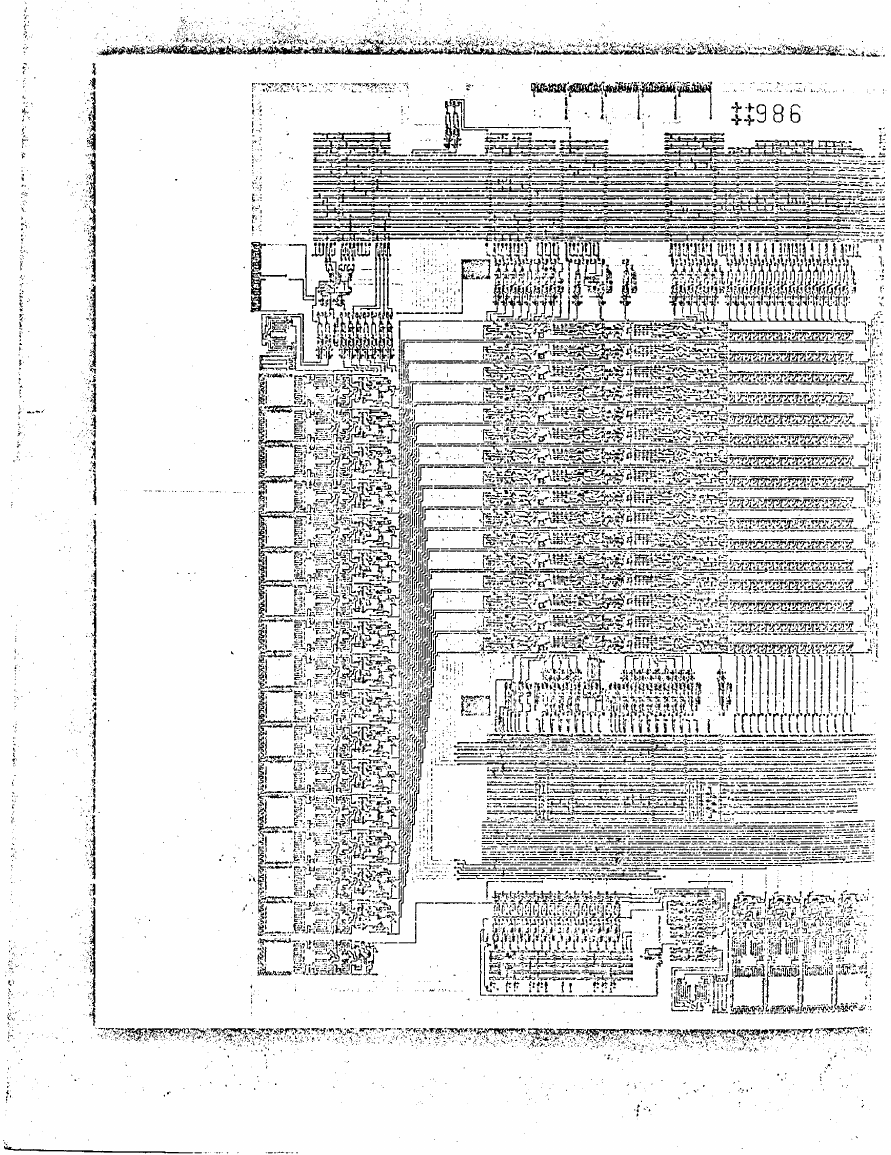
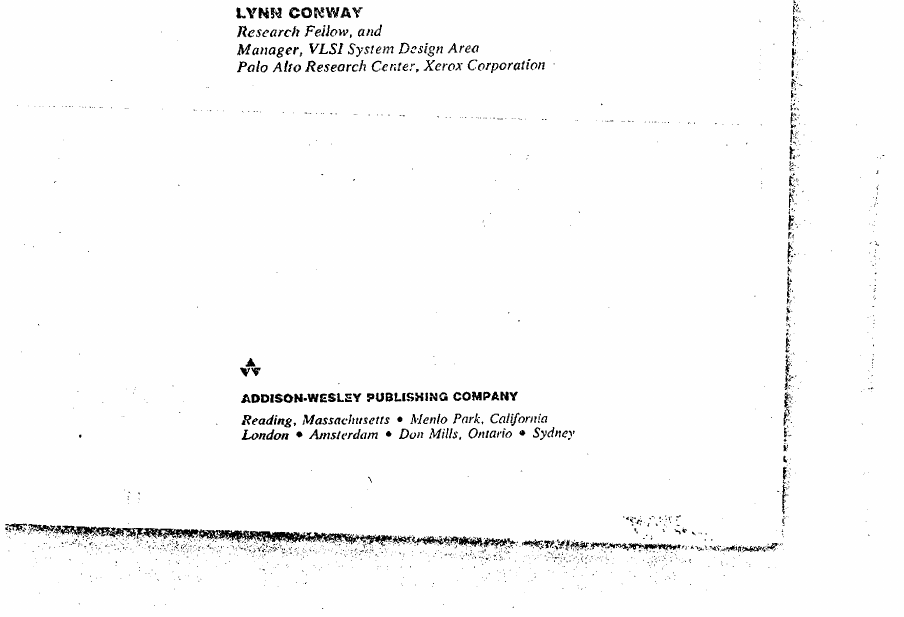
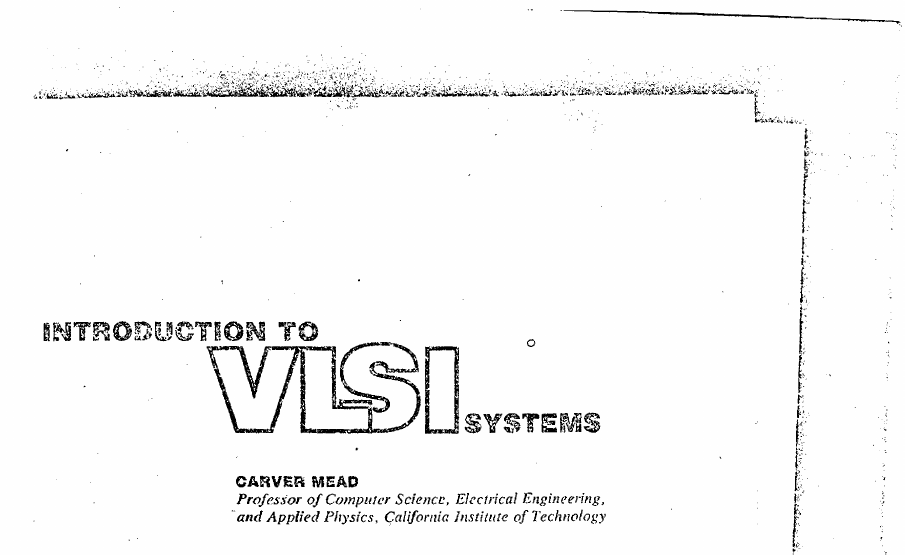
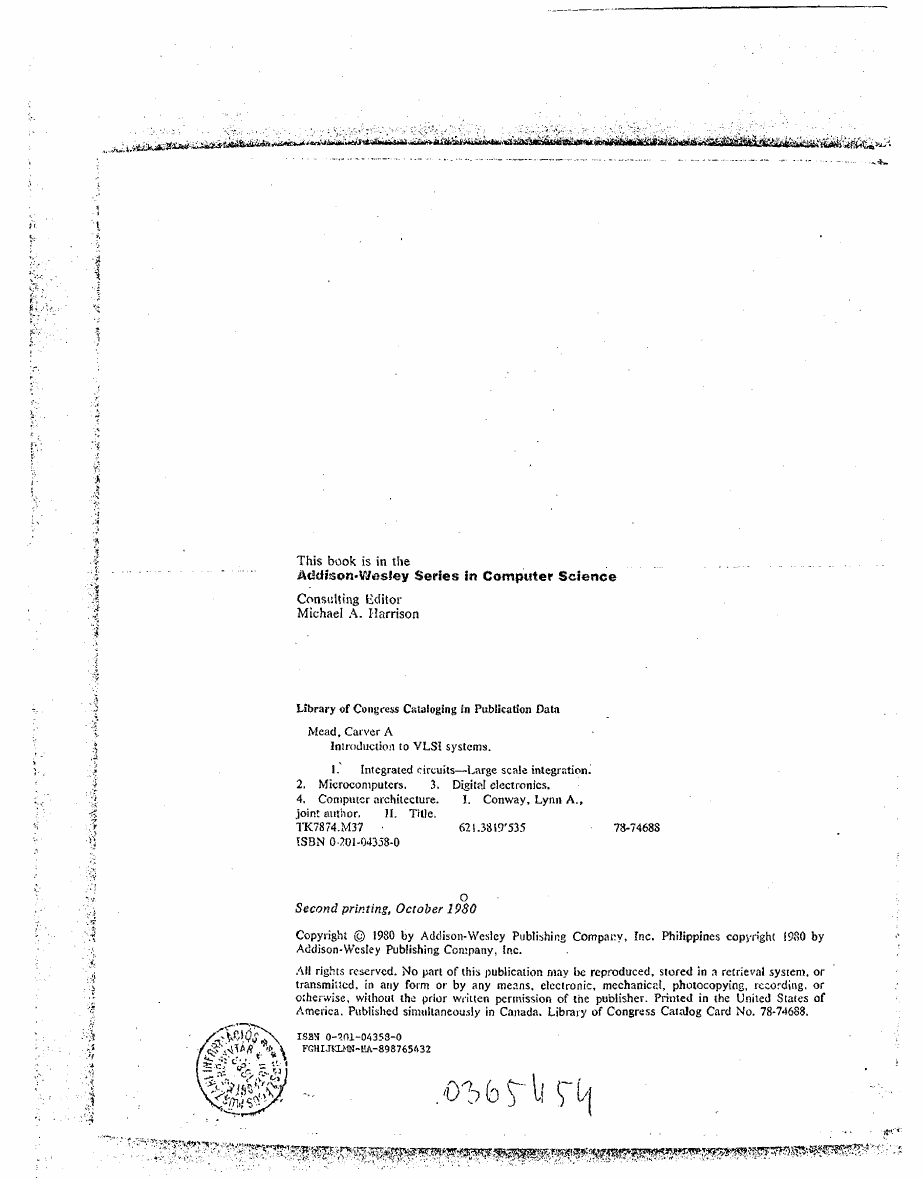

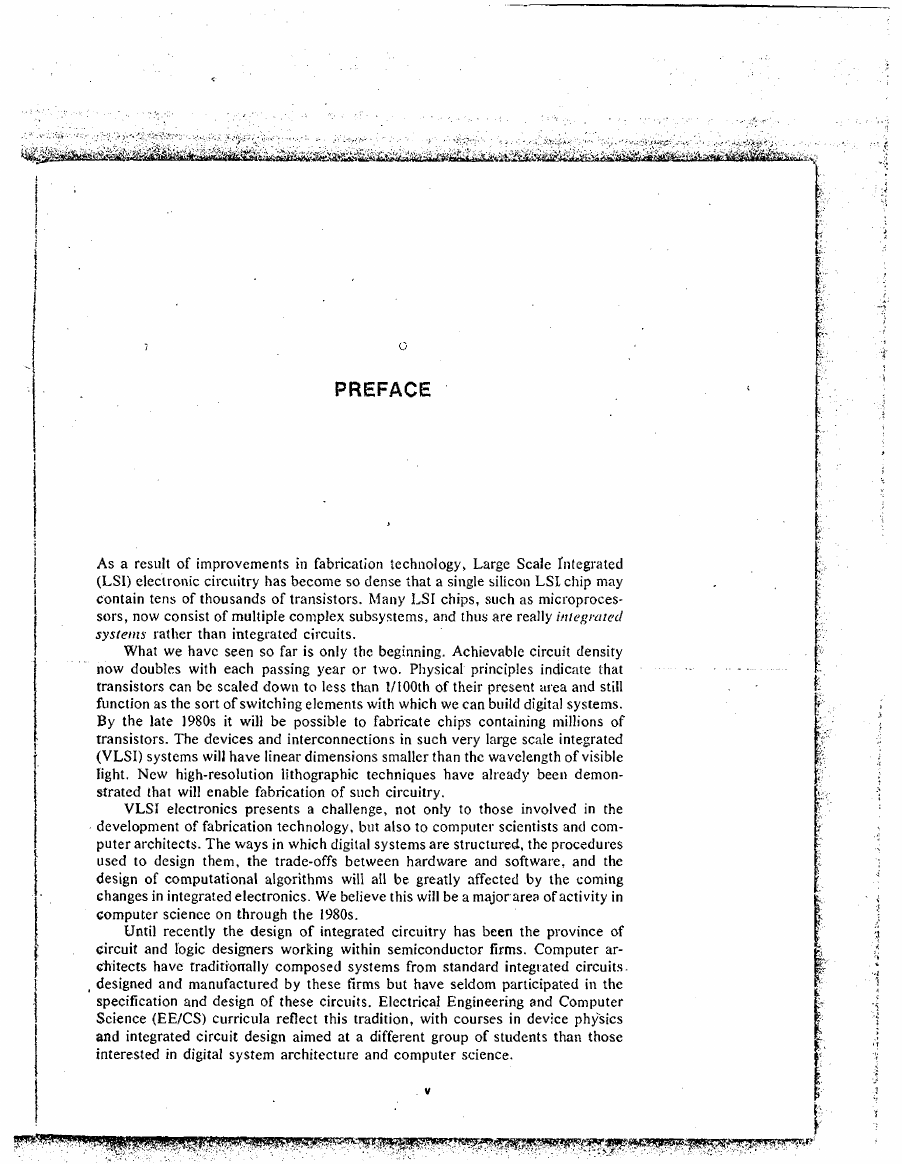
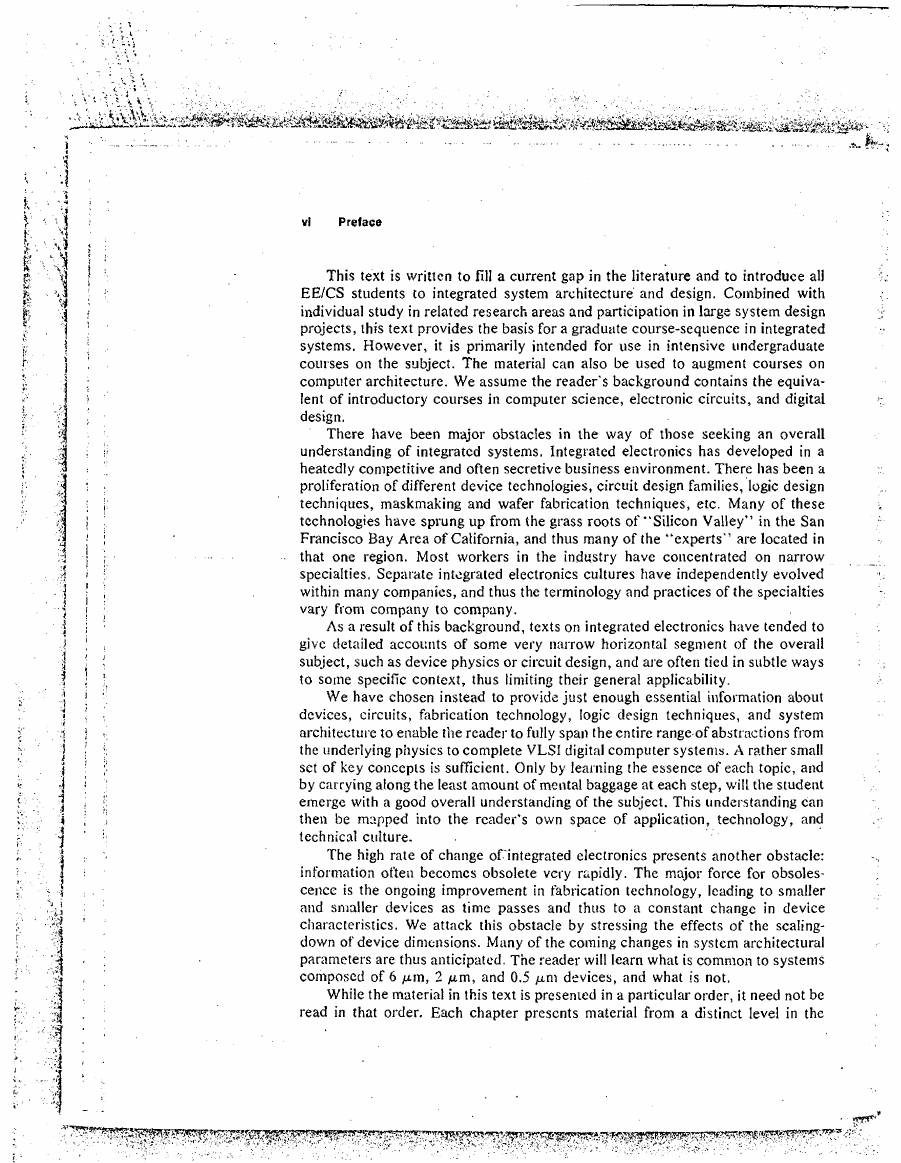
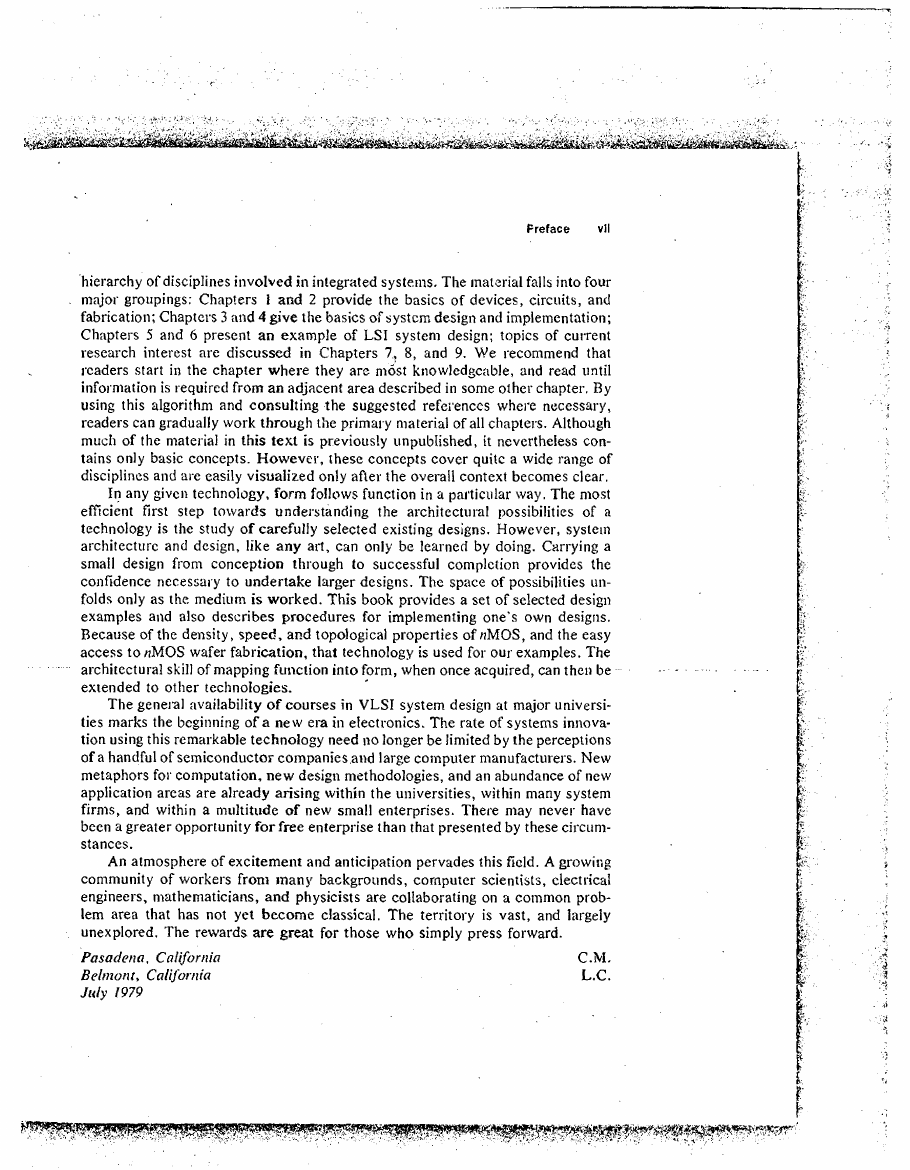








 2023年江西萍乡中考道德与法治真题及答案.doc
2023年江西萍乡中考道德与法治真题及答案.doc 2012年重庆南川中考生物真题及答案.doc
2012年重庆南川中考生物真题及答案.doc 2013年江西师范大学地理学综合及文艺理论基础考研真题.doc
2013年江西师范大学地理学综合及文艺理论基础考研真题.doc 2020年四川甘孜小升初语文真题及答案I卷.doc
2020年四川甘孜小升初语文真题及答案I卷.doc 2020年注册岩土工程师专业基础考试真题及答案.doc
2020年注册岩土工程师专业基础考试真题及答案.doc 2023-2024学年福建省厦门市九年级上学期数学月考试题及答案.doc
2023-2024学年福建省厦门市九年级上学期数学月考试题及答案.doc 2021-2022学年辽宁省沈阳市大东区九年级上学期语文期末试题及答案.doc
2021-2022学年辽宁省沈阳市大东区九年级上学期语文期末试题及答案.doc 2022-2023学年北京东城区初三第一学期物理期末试卷及答案.doc
2022-2023学年北京东城区初三第一学期物理期末试卷及答案.doc 2018上半年江西教师资格初中地理学科知识与教学能力真题及答案.doc
2018上半年江西教师资格初中地理学科知识与教学能力真题及答案.doc 2012年河北国家公务员申论考试真题及答案-省级.doc
2012年河北国家公务员申论考试真题及答案-省级.doc 2020-2021学年江苏省扬州市江都区邵樊片九年级上学期数学第一次质量检测试题及答案.doc
2020-2021学年江苏省扬州市江都区邵樊片九年级上学期数学第一次质量检测试题及答案.doc 2022下半年黑龙江教师资格证中学综合素质真题及答案.doc
2022下半年黑龙江教师资格证中学综合素质真题及答案.doc